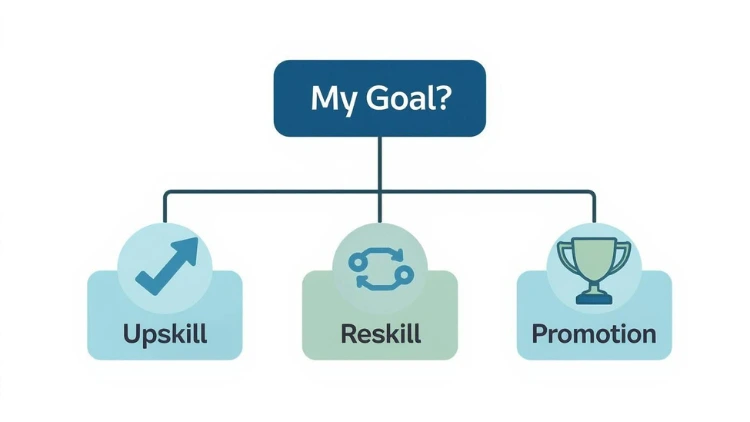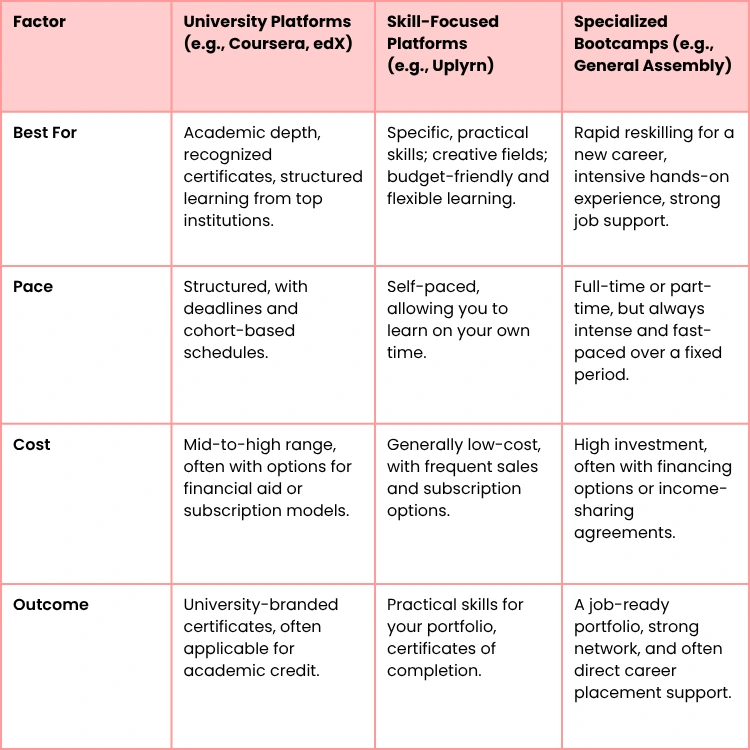Online Courses for Career Growth: A Practical Guide

Ever feel like your career has hit a wall while everyone else is climbing the ladder? You're definitely not the only one. In a job market that moves at lightning speed, online courses have become the sharpest tool in the shed for real, practical career growth.
This is your roadmap for turning a digital certificate into a tangible promotion or a brand-new career path.
Jump To Section

Earn As You Learn
Earn 25% commission when your network purchase Uplyrn courses or subscribe to our annual membership. It’s the best thing ever. Next to learning,
of course.
Why Online Courses Are a Career Game-Changer
When your career feels like it's stuck in neutral, you need a direct path to the next level. Traditional education can be a slow, expensive detour. Online courses, on the other hand, offer a nimble way to pick up relevant, in-demand skills without hitting pause on your entire life.
Think of them as a bridge connecting where you are now to where you want to be.
This is about more than just padding your resume. It's about building the exact expertise that solves the problems employers are wrestling with right now. The modern workplace is staring down a massive skills gap, and online learning is one of the fastest ways to close it for yourself. We dive deeper into this issue right here.
The Proof is in the Paycheck
The impact here isn't just a vague feeling of accomplishment; it's backed by real numbers. A stunning 68% of people who take online courses say it directly helped them move up in their careers.
Employers are on board, too. 58% of hiring managers now see online certifications as just as credible as traditional degrees. That’s a huge shift, giving digital credentials real weight in the job market.
This means your learning can lead to concrete results. For example, a marketing coordinator could take a specialized course in SEO analytics. By immediately building a performance dashboard for the company website, they show undeniable value and make a strong case for a promotion to a digital marketing specialist role.
Actionable Insight: The real magic of online courses is their ability to deliver specific, job-ready skills on your schedule. You can learn Python on a Tuesday night and use it on a data project at work Wednesday morning.

Defining Your Career Goals Before You Learn
Jumping into the first interesting course you see is a classic mistake. It feels productive, but without a clear destination in mind, you're just wandering aimlessly through a curriculum. To make online courses actually work for your career, you have to start by defining what that career growth looks like.
Think of it like building a bridge. You wouldn't just start laying foundations without knowing exactly where the other side is. Vague goals like "get better at marketing" are the equivalent of building into a fog—they won't get you anywhere specific. A sharp, actionable goal is what gives your learning a powerful purpose.
Reverse Engineer Your Dream Job
One of the most practical ways to get this clarity is to work backward from the job you actually want. Don't just daydream about it; turn it into a research project. This simple exercise cuts through the noise and shows you exactly which skills will move the needle in your career.
Here’s a straightforward, actionable way to do it:
- Find 5-10 Job Descriptions: Head over to a job site like LinkedIn and search for the role you want in the next two to five years. If you're a junior data analyst, you might search for "Senior Data Analyst" or "Data Scientist".
- Hunt for Skill Patterns: Copy and paste the "Requirements" or "Qualifications" sections into a single document. Start looking for the skills that pop up again and again. You’ll probably notice that nearly every senior role requires Python, SQL, and experience with a specific visualization tool like Tableau.
- Map Your Gaps: Make a list of these in-demand skills. Now, be honest with yourself—which ones do you have, and which ones are you missing or need to seriously level up? This is your personal skills gap analysis, and it's gold.
This process turns learning from a guessing game into a targeted strike. A content writer who wants to become a Content Marketing Manager, for example, might discover that "SEO strategy", "Google Analytics", and "project management software" are the big three requirements. Suddenly, their learning priorities are crystal clear.
From Vague Ideas to Actionable Steps
Once you've identified the skills, the next move is to frame them as clear learning objectives. This makes choosing the right online course infinitely easier.
Actionable Insight: Vague ambitions lead to abandoned courses. Specific, goal-oriented learning leads to completed certificates and tangible career progress.
Let's see how this plays out with a practical example. Imagine a customer service representative wants to move into a team lead position. After digging through job descriptions, they find a consistent demand for "conflict resolution" and "performance coaching" skills.
- Vague Goal: "I need to get better at leadership."
- Actionable Goal: "I need to find a course that teaches practical frameworks for de-escalating customer conflicts and providing constructive feedback to team members."
See the difference? That level of detail ensures you're not just collecting certificates, but building the specific competencies that get you hired or promoted. For a more structured approach, this guide on how to set personal goals can give you an even deeper framework for success.
When you define your destination first, every online course you take becomes a deliberate, powerful step forward.
How To Find And Vet The Right Online Courses
Okay, you’ve pinpointed your career goals. Now comes the fun part: diving into the vast ocean of online education to find the course that’ll get you there. It’s easy to feel overwhelmed by the sheer number of options, but with the right approach, you can turn this search into a strategic mission.
The trick is to learn how to evaluate programs like a pro, moving beyond just big platform names to find courses that deliver real, tangible value.
And there’s a good reason for this. The online education market is booming. Back in 2022, it was valued at a staggering £179 billion globally. Corporate e-learning, in particular, has exploded—an incredible 90% of corporations now use it for employee training, a massive leap from just 4% in 1995.
This growth is great for us—more choice is always a good thing—but it also means our vetting process has to be sharper than ever.
This decision tree gives you a simple framework for matching your goals—whether you’re looking to upskill, reskill, or climb the ladder—with the perfect learning path.
As you can see, the kind of career move you want to make should directly shape your course choice. Following this logic keeps you from wasting time and money on content that isn't quite right.

Choosing Your Learning Path: Key Considerations
Before you commit, it's worth thinking about the different types of learning platforms out there and what they offer. Each has its own strengths, depending on what you're trying to achieve.
Scrutinize The Syllabus And Instructor
Think of the course syllabus as your treasure map. It shows you exactly what you’ll learn and, more importantly, what you’ll be able to do. A great syllabus focuses on application, not just abstract theory.
Look for modules that end with a tangible project. Maybe you’ll build a functional app, create a complete marketing campaign, or develop a detailed financial model. For instance, if you're a graphic designer moving into UX, a course that only covers design principles is far less valuable than one that has you build a full, portfolio-ready case study for a mobile app. That project-based approach is what transforms head knowledge into a skill you can actually prove.
The instructor's background is just as crucial. Are they a respected academic or an industry pro with years of hands-on experience? Neither is automatically better, but one will probably align more closely with your goals.
Practical Example: An instructor who has "been there and done that" often provides practical insights and real-world shortcuts that you simply can't find in a textbook. Their experience is part of what you're paying for.
Read Between The Lines Of Reviews
Student reviews are an absolute goldmine, but you need to know how to dig. Don't just glance at the star rating. Dive into the actual written feedback and look for patterns.
Try this actionable checklist to find answers to these specific questions:
- Was the content up-to-date? Technology and business strategies change fast. A digital marketing course from 2020 might already be seriously outdated.
- How was the instructor support? Keep an eye out for comments about instructors answering questions in forums or giving feedback on assignments. A responsive instructor can make all the difference.
- Did students actually achieve their goals? This is the big one. Look for reviews from people who had similar goals to yours. If someone says, "This course helped me land a job as a data analyst", that’s a powerful signal.
Considering these details is key to picking a course that doesn't just teach you something but also delivers a great learning experience.
By combining a solid curriculum, an experienced instructor, and positive, goal-oriented reviews, you can confidently choose online courses for career growth that deliver real, measurable results.
This table isn't about which one is "best", but which one is best for you. A bootcamp might be perfect for a career changer, while a seasoned professional might just need a specific skill from an Uplyrn course.

Building a Learning Habit That Actually Sticks
Signing up for an online course is the easy part. The real test? Weaving that learning into an already packed life without completely burning out. The secret isn't about magically finding more hours in the day—it's about building a smart, sustainable system that makes learning a consistent and manageable part of your week.
The biggest mistake we see people make is just passively consuming content. To make knowledge stick, you have to move from just watching videos to actually applying what you've learned. This hands-on approach is what builds real confidence and gives you tangible proof of your new skills.
From Passive Watching to Active Doing
Active learning is what turns theory into expertise. Say you're taking a course on Google Analytics. Don't just click through the modules and take the quizzes. Find a real-world application. Volunteer to build a custom performance dashboard for a project at your current job.
This approach pays off in two huge ways. First, you reinforce what you've learned by solving a genuine problem. Second, you create a visible accomplishment you can point to in a performance review or your next job interview. That’s how a digital certificate becomes a career-changing asset.
Actionable Insight: The most successful learners treat their courses less like a classroom and more like a workshop. They are constantly building, testing, and applying concepts in real-world scenarios, which cements the knowledge far more effectively than passive observation ever could.
To make this all click, you'll need to develop some proven study habits. This is the foundation for turning ambition into actual skill acquisition.
Create a Realistic Learning Schedule
Let us be clear: consistency beats intensity every single time. A frantic, all-night cram session is way less effective than regular, focused study blocks. You need to make learning an unbreakable appointment with yourself.
Here’s a simple, actionable framework to get started:
- Time-Block Your Calendar: Schedule non-negotiable 45-minute study sessions two or three times a week. Seriously, put them on your calendar and treat them like any other important meeting.
- Break It Down: A massive topic like "Machine Learning Fundamentals" can feel overwhelming. Break the course into its smallest parts—like "Understanding Regression Models"—and tackle just one bite-sized piece per session.
- Define a Session Goal: Never start a study block without a clear objective. For example: "Today, I will complete the module on pivot tables and then replicate the example with my own dataset."
This kind of structure removes the guesswork. You don't have to waste mental energy deciding what to do; you just sit down and start. If you want to dive deeper into making this work, exploring the power of routine can seriously supercharge your efforts.
The data backs this up, too. Online learning can cut down study time by a whopping 40–60% compared to traditional classroom settings. Plus, 85% of students report that it improved their critical thinking—a skill every employer is looking for. With 70% of students now seeing online classes as a better alternative, having a solid plan is the only way to get the most out of them.

Turning Your New Skills Into Career Wins
Finishing an online course is a fantastic achievement, but let's be real—the certificate is just the starting line. The real win comes from putting that newfound expertise to work and turning it into actual career opportunities. It’s time to cash in on all that hard work.
This is about more than just adding another line to your resume. You need to show, not just tell, how these new skills make you a more valuable player on your team and in your industry.
Showcase Your Skills Where It Counts
Think of your professional profiles, especially LinkedIn, as your personal brand's storefront. Don't just toss your certificate into the "Licenses & Certifications" section and move on. To really make an impact, you need to weave those new skills throughout your entire profile.
Start with your headline. A "Marketing Coordinator" can instantly level up to a "Marketing Coordinator | SEO & Content Strategy Specialist". This simple tweak immediately signals your expanded capabilities to recruiters and anyone in your network.
Then, make sure to add the specific skills from your course to the "Skills" section. This isn't just vanity; it's about backing up your claims. After all, a whopping 90% of learners say they feel more confident at work after finishing a course. Let your profile reflect that confidence.
Turn Learning Into Tangible Projects
A dedicated "Projects" section on your resume is one of the most powerful tools you have. This is where you transform abstract knowledge into concrete proof of what you can actually do. Honestly, it’s a game-changer that makes your skills impossible for a hiring manager to ignore.
Here’s a practical example of how to frame a project from one of your online courses for career growth:
- Project Title: Customer Churn Prediction Model
- Skills Used: Python, Pandas, Scikit-learn, Data Visualization
- Description: Built a predictive model using a dataset of 10,000 customer records to flag clients at high risk of churn. The model achieved 85% accuracy, giving the retention team clear, actionable insights.
This format proves you can apply what you learned to solve a legitimate business problem. Nailing your resume is an art, and if you want to dig deeper, this guide on how to write a resume that will actually get a recruiter's attention has you covered.
Actionable Insight: A certificate says you learned something. A project proves you can do something. Employers hire people who can do things.
Master the Conversation in Reviews and Interviews
When performance review season rolls around or you're in a job interview, the way you talk about your new skills is critical. Don’t be generic. You have to connect the dots for your manager or the person across the table.
Instead of just saying, "I took a course on project management", frame it in a way that highlights the direct value you bring.
- The Old Way: "I completed a course on project management."
- The New, Better Way (A Practical Example): "I recently earned my certification in Agile Project Management, where I got hands-on with frameworks like Scrum and Kanban. I'm excited to apply these methods to help streamline our team's workflow, speed up our project delivery, and bring more transparency to our key initiatives."
This approach does three crucial things:
- It names the specific, industry-recognized skills you’ve learned.
- It directly ties that learning to a real business need (like faster project delivery).
- It shows you're proactive and already thinking about how to add more value.
By translating your education into clear business benefits, you build an undeniable case for that promotion, raise, or exciting new role. You're not just a learner anymore; you're a problem-solver who’s ready to make an impact.

Common Questions About Online Career Courses
Even with the best plan in hand, we get it—investing your time and money into online learning can feel like a big step. It’s natural to have questions, and getting straight answers is the only way to move forward with real confidence.
Let's clear the air and tackle some of the most common concerns we hear from professionals just like you.
Are Online Course Certificates Actually Valued by Employers?
Yes, but with a crucial caveat. Certificates are absolutely valued, especially when they come from a reputable source that’s known in your industry. In fact, a recent study showed 58% of hiring managers see online certifications as just as credible as traditional degrees.
This is especially true for fast-moving fields like tech and business, where practical, up-to-date knowledge is what really matters.
But here’s the thing: the certificate itself isn’t the prize. It’s proof that you’ve done the work. The real power comes when you can show you’ve actually applied what you learned. A digital marketing certificate from a major platform is good; pairing it with a portfolio project where you built a real campaign is a game-changer.
Practical Example: A certificate proves you learned the concepts. A project demonstrates you mastered the skills. Employers are far more interested in the latter.
How Do I Find Time for Courses with a Full-Time Job?
This is the million-dollar question, isn't it? The secret is to aim for consistency, not intensity. Trying to cram marathon study sessions into an already packed schedule is a fast track to burnout. You have to build small, sustainable learning habits that fit into the life you already have.
This is where the flexibility of online learning becomes your superpower. You can reclaim small pockets of time that would otherwise disappear.
- Block it out: Schedule just two or three 30-45 minute learning sessions into your calendar each week. Treat them like any other important meeting you can't miss.
- Learn on the move: Is your commute spent scrolling? Download lectures or course materials to listen to or read on the train or bus.
- Use your lunch break: Even 20 minutes of your lunch break can be enough to watch a module or knock out a quick exercise.
Trust us, a course you finish steadily over three months is infinitely more valuable than one you start with a burst of enthusiasm and abandon after one week.
Which Skills Offer the Best Career Growth Potential?
While this is always going to depend on your specific industry, the trend is clear: the future belongs to those who blend sharp digital skills with timeless "human" skills.
On the technical side, competencies in fields like data analytics, AI, digital marketing, and cybersecurity are red-hot across almost every sector. These are the hard skills that get you in the door.
But don't sleep on the soft skills that actually drive leadership and influence. Job reports from LinkedIn and others consistently scream about the growing need for:
- Complex problem-solving
- Strategic communication
- Leadership and people management
The single most effective strategy? Go to a job board and pull up 5-10 descriptions for the role you want next. The skills that keep showing up over and over again—that's your roadmap. That's what the market is telling you it values right now.
Ready to turn your career ambitions into reality? At Uplyrn, we provide the skills ecosystem you need to succeed, connecting you with expert-led courses and a supportive community. Start your learning journey with Uplyrn today.


Leave your thoughts here...
All Comments
Reply